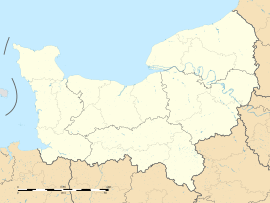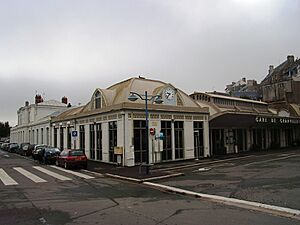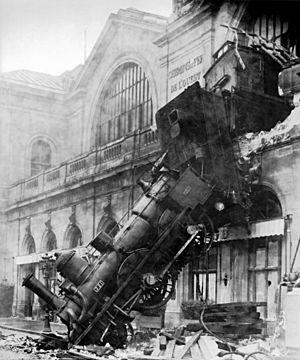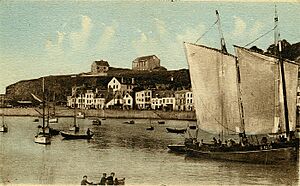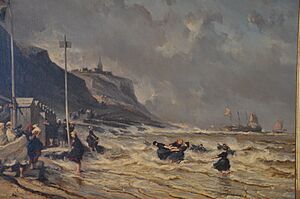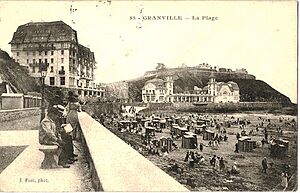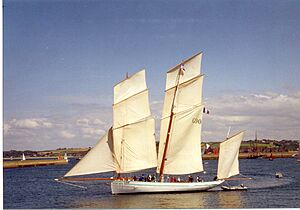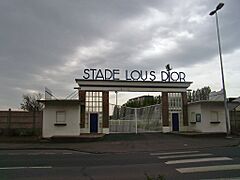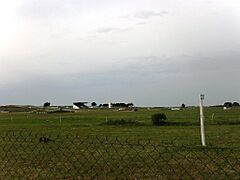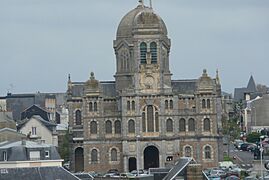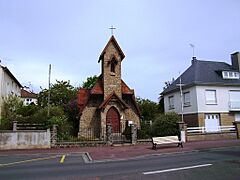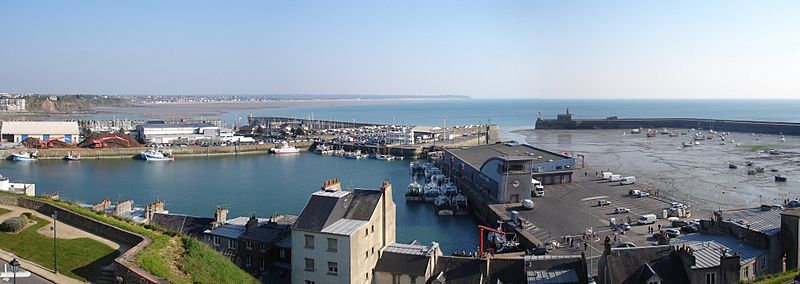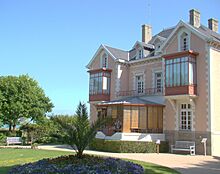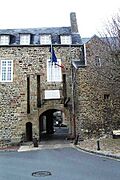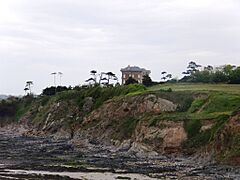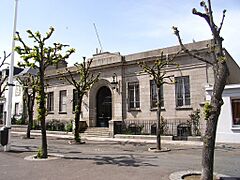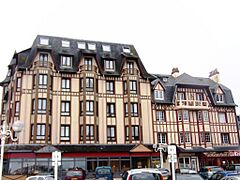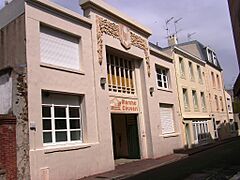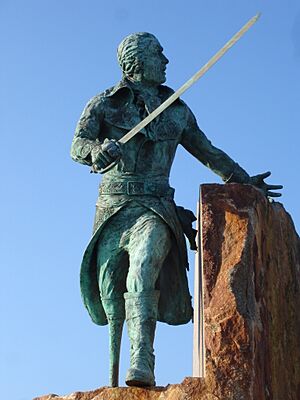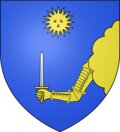Granville, Manche facts for kids
Quick facts for kids
Granville
|
||
|---|---|---|
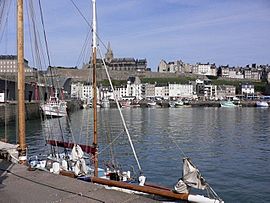
The harbour of Granville, with Notre-Dame church in the background
|
||
|
||
| Country | France | |
| Region | Normandy | |
| Department | Manche | |
| Arrondissement | Avranches | |
| Canton | Granville | |
| Intercommunality | Granville, Terre et Mer | |
| Area
1
|
9.9 km2 (3.8 sq mi) | |
| Population
(2021)
|
12,581 | |
| • Density | 1,271/km2 (3,291/sq mi) | |
| Time zone | UTC+01:00 (CET) | |
| • Summer (DST) | UTC+02:00 (CEST) | |
| INSEE/Postal code |
50218 /50400
|
|
| Elevation | 0–67 m (0–220 ft) (avg. 37 m or 121 ft) |
|
| 1 French Land Register data, which excludes lakes, ponds, glaciers > 1 km2 (0.386 sq mi or 247 acres) and river estuaries. | ||
Granville is a charming town in Normandy, northwestern France. It's known as a popular seaside resort and a health resort located in the beautiful Mont Saint-Michel Bay. People sometimes call it the "Monaco of the North" because it sits on a rocky hill overlooking the sea.
This town was started in the 11th century by a knight who served William the Conqueror. It used to be a strong fortification that helped protect Mont Saint-Michel. Later, in the 19th century, Granville became a famous place for holidays. Many artists visited, and it got a golf course and a horse racing track.
Granville is also the hometown of the famous Dior family, known for their businesses. Since 1991, it has been a "Douzelage" city, which means it's twinned with 20 other European cities to promote friendship and cooperation. The Chausey islands, which are French islands in the Channel, are also part of Granville.
Contents
Discover Granville
Where is Granville?
Granville is right on the edge of the English Channel, at the northern part of the Mont Saint-Michel Bay. The town's older part is on a peninsula with cliffs, called Pointe du Roc. The rest of the town spreads out towards the east. A small river called the Boscq runs to the north, and to the south, you'll find beaches and cliffs.
The town has four sandy beaches. One is to the north, and three are to the south. Granville covers about 9.9 square kilometers (3.8 square miles). Much of this area is built up, but there are rules to protect the coastline and natural areas.
Granville is about 288 kilometers (179 miles) west of Paris. It's also 40 kilometers (25 miles) southwest of Saint-Lô and 23 kilometers (14 miles) north of Mont Saint-Michel.
Land and Water
Most of Granville is at sea level. It only gets a bit higher towards the inland areas and on the peninsula, reaching up to 67 meters (220 feet) at its highest point.
Granville is famous for having some of the highest tides in Europe, which can go up to 14 meters (46 feet)! This means the coastline can look very different between high and low tide.
Off the coast, the Chausey Islands are part of Granville. This group of islands is unique because it's one of the few island areas in France that are part of a town. At high tide, there are 52 islands, but at low tide, you can see more than 365!
Nearby Towns
Granville is surrounded by the English Channel on three sides. To the northeast is Donville-les-Bains, and to the east is Yquelon. To the southeast, you'll find Saint-Pair-sur-Mer and Saint-Planchers. The Chausey islands are to the northwest, and Mont Saint-Michel is to the south.
Weather in Granville
Granville has an oceanic climate because it's on the coast. It's usually protected from strong storms and winds, and the temperatures are mild. The average temperature is around 11.4°C (52.5°F). Summers are warm, with temperatures around 21°C (70°F) in July and August, and winters are mild, around 3°C (37°F) in January and February.
It doesn't rain as much as some people think in Normandy, with about 606 millimeters (23.9 inches) of rain each year. The strongest wind ever recorded in Granville was 220 km/h (137 mph) during a big storm in 1987.
| Climate data for Granville (1961–1990) | |||||||||||||
|---|---|---|---|---|---|---|---|---|---|---|---|---|---|
| Month | Jan | Feb | Mar | Apr | May | Jun | Jul | Aug | Sep | Oct | Nov | Dec | Year |
| Mean daily maximum °C (°F) | 8.8 (47.8) |
9.3 (48.7) |
11.9 (53.4) |
13.7 (56.7) |
17.0 (62.6) |
19.8 (67.6) |
21.9 (71.4) |
22.0 (71.6) |
20.0 (68.0) |
16.3 (61.3) |
12.0 (53.6) |
9.2 (48.6) |
15.2 (59.4) |
| Mean daily minimum °C (°F) | 3.4 (38.1) |
3.1 (37.6) |
4.8 (40.6) |
5.9 (42.6) |
9.0 (48.2) |
11.5 (52.7) |
13.5 (56.3) |
13.6 (56.5) |
11.7 (53.1) |
9.4 (48.9) |
6.1 (43.0) |
3.7 (38.7) |
8.0 (46.4) |
| Average precipitation mm (inches) | 57.0 (2.24) |
53.2 (2.09) |
49.9 (1.96) |
39.7 (1.56) |
50.5 (1.99) |
40.8 (1.61) |
36.8 (1.45) |
36.3 (1.43) |
50.8 (2.00) |
59.0 (2.32) |
68.5 (2.70) |
64.3 (2.53) |
606.8 (23.89) |
| Average precipitation days (≥ 1.0 mm) | 12.7 | 10.7 | 11.0 | 9.2 | 9.7 | 7.4 | 6.1 | 6.4 | 8.7 | 10.5 | 13.3 | 12.8 | 118.5 |
| Average snowy days | 1.3 | 2.1 | 0.6 | 0.3 | 0.0 | 0.0 | 0.0 | 0.0 | 0.0 | 0.0 | 0.2 | 0.8 | 5.3 |
| Average relative humidity (%) | 87 | 84 | 82 | 80 | 79 | 80 | 79 | 78 | 79 | 82 | 84 | 86 | 81.7 |
| Mean monthly sunshine hours | 69.5 | 84.3 | 127.5 | 164.1 | 188.4 | 206.4 | 206.4 | 198.6 | 167.1 | 112.6 | 77.8 | 64.0 | 1,666.6 |
| Source 1: Meteofrance.com (Temperatures, sunshine hours) | |||||||||||||
| Source 2: Infoclimat.fr | |||||||||||||
Getting Around Granville
Granville is easy to reach by different roads. There are also train services from Paris to Granville.
You can also travel by bus within Granville and to nearby towns. The Granville-Mont-Saint-Michel Airport is available for private planes.
By sea, the port of Granville connects to the Chausey Islands and the Channel Islands. It's also a busy port for cargo.
Different Areas of Granville
Granville is divided into several areas. The Haute Ville (Upper Town) is the historic heart, surrounded by old walls. Other areas include Couraye, La Tranchée, Le Calvaire, Le Centre (the modern town center), and Saint-Nicolas, which used to be a separate village.
What's in a Name?
The name Granville comes from old French words. Gran- means "grand" or "big," and -ville means "village" or "domain." So, it likely means "big village" or "big domain."
Some old maps from the 18th century showed the name Grannonum where Granville is now. But experts today don't think Granville is linked to that old Roman name.
During the French Revolution, the town was briefly called Granville-la-Victoire (Granville the Victory) because it successfully defended itself in 1793. The name of Cap Lihou comes from an old Norse word meaning "island."
History of Granville
Early Days
Legend says that Granville and the Chausey islands were once part of a big forest that sank in the year 709.
In 1066, a family named Grant helped William the Conqueror. As a reward, he gave them the lands of Roque de Lihou, which is where Granville is today. So, the Grants were the first lords of the town after the Vikings.
In 1439, during the Hundred Years' War, an English officer named Sir Thomas de Scales bought the area. To cut off Mont Saint-Michel from French territory, he ordered the building of Granville's strong walls. A ditch was also dug to make the peninsula an island.
However, in 1442, a French leader named Louis d'Estouteville cleverly took the castle back. Since then, Granville has always been French. King Charles VII made Granville a fortified town and gave its people special rights, like not having to pay taxes.
By 1450, ships from Granville were already fishing far away in Newfoundland. In 1492, Jewish families from Spain, who were expelled from their country, settled in Granville. Their skills in trade and lending money helped the town build a large fleet of ships.
From Privateers to Seaside Resort

In 1562, the town's walls were repaired, and soldiers moved into barracks. Later, under King Louis XIV, Granville ships were allowed to capture enemy ships, becoming "privateers." Granville gave France 15 admirals, including the famous Georges René Le Peley de Pléville.
In 1695, during a war, English warships attacked Granville for 8 hours, destroying many houses. After this, the walls were made even stronger. The port was also expanded with a new breakwater, which is still there today.
On November 14, 1793, during the French Revolution, a large army of Vendéens (royalist rebels) tried to take Granville. They expected British ships to help them, but no ships arrived. The town's defenders fought bravely and pushed them back. The Vendéens had to retreat, burning part of the town as they left.
After years of war, Granville started to change. In 1856, a new wet dock and lock were opened at the port, giving it its modern look. In 1860, the first wooden casino was built, making Granville a popular seaside resort. Famous writers like Stendhal and Victor Hugo visited.
In 1870, the railway line to Paris opened, making it even easier for visitors to come. The town continued to grow, adding a library, schools, and a dry dock for ships. To entertain holidaymakers, a horse racing course opened in 1890 and a golf course in 1912.
In 1905, the famous fashion designer Christian Dior was born in Granville. His childhood home is now a museum. The town also got electricity in 1912.
World War II and Beyond
During World War II, German forces occupied Granville in June 1940. They built defenses on the Pointe du Roc and closed off the port. Many people in Granville resisted the occupation. A local teacher named Maurice Marland led a resistance network, helping British soldiers escape and gathering information about enemy activities. He was arrested and shot by German forces in 1944.
Granville was freed on July 31, 1944, without a fight. However, in a surprising event on March 9, 1945, German soldiers from Jersey launched a daring raid on Granville's port. They blew up facilities, sank ships, and freed German prisoners before retreating.
After the war, Granville continued to develop. In 1962, the nearby village of Saint-Nicolas-près-Granville joined Granville. In 1975, a marina was added to the port. The town also got a new hospital in 1982.
In the 1980s, a Museum of modern art opened thanks to donations from Richard Anacréon. In 1991, the Christian Dior Museum opened in the fashion designer's childhood home.
Today, Granville is a modern town that balances its rich history with its role as a popular tourist destination and economic center.
People of Granville
Population Growth
In 1793, Granville had 6,649 people. The population grew to its highest in 1861 with 17,180 residents. However, after the war of 1870 and World War I, the number of people decreased.
In the second half of the 20th century, with the addition of Saint-Nicolas-près-Granville in 1962 and new housing, the population grew again. In 2006, there were 13,022 people living in Granville.
| Historical population | |||||||||||||||||||||||||||||||||||||||||||||||||||||||||||||||||||||||||||||||||||||||||||||||||||||||||||||||||||||||
|---|---|---|---|---|---|---|---|---|---|---|---|---|---|---|---|---|---|---|---|---|---|---|---|---|---|---|---|---|---|---|---|---|---|---|---|---|---|---|---|---|---|---|---|---|---|---|---|---|---|---|---|---|---|---|---|---|---|---|---|---|---|---|---|---|---|---|---|---|---|---|---|---|---|---|---|---|---|---|---|---|---|---|---|---|---|---|---|---|---|---|---|---|---|---|---|---|---|---|---|---|---|---|---|---|---|---|---|---|---|---|---|---|---|---|---|---|---|---|---|
|
|
|
|||||||||||||||||||||||||||||||||||||||||||||||||||||||||||||||||||||||||||||||||||||||||||||||||||||||||||||||||||||
| From 1962 to 1999: Population without double counting; for the years following: municipal population. Source: Ldh/EHESS/Cassini until 1999 and INSEE (1968–2017) |
|||||||||||||||||||||||||||||||||||||||||||||||||||||||||||||||||||||||||||||||||||||||||||||||||||||||||||||||||||||||
Age Groups
Granville has a good mix of ages among its residents. Each age group, from children to older adults, makes up a similar part of the population. This shows a balanced community.
|
|
||||||||||||||||||||||||||||||||||||||||||||||||||||||||||||||||||||||||||||||||||||||||||||||||||||||||||||||||||||||||||||||||||||||||||||||||||||||||||||||||||||||||||||||||||||||||
Life in Granville
Culture and Fun
Granville has many cultural places to visit. There are three museums:
- The Christian Dior Museum is in the house where the famous fashion designer grew up. You can learn about his life and the history of fashion.
- The Museum of the Old Granville tells the story of the city.
- The Richard Anacréon Modern Art Museum shows modern art.
You can also visit an aquarium on the Pointe du Roc, which has many kinds of marine fish. There are also exhibition spaces like the Féerie des Coquillages (Enchantment of the Shells) and the Jardin des Papillons (Butterfly Garden).
For entertainment, Granville has a media library, a large multipurpose hall for shows, a small theatre, and a cinema. There's also a music school and many local groups that help organize cultural events.
Sports and Activities
Granville offers many sports facilities. There's a "City of Sports" with football and rugby pitches, basketball courts, an athletics track, and areas for judo and gymnastics. You can also find a skatepark and a BMX track.
The town has a covered swimming pool, tennis courts, and a sea rowing club. The Regional Sailing Centre is here, along with a 27-hole golf course built in 1912 right by the sea. There's also an equestrian club and a racecourse for horse racing.
In cycling, Granville has been a stage town for the Tour de France. In sailing, Granville hosts a stage of the Tour de France à la voile every year. You can also see the famous Bisquine boat races, where La Granvillaise competes against La Cancalaise.
- Sports facilities of Granville
Places of Worship
Granville has several Catholic churches, including Notre-Dame-du-Cap-Lihou, Saint Paul, and Saint Nicolas. There are also Protestant churches for different faiths.
- Churches of Granville
Local Media
Local newspapers like La Manche Libre and Ouest-France have offices in Granville and publish local news. You can also watch the regional television channel France 3 Normandie.
Granville's Economy
Granville is an important economic center in the south of the Manche area. It has a business incubator to help new companies start up. Some of the biggest employers in town include the Le Normandy thalassotherapy center and the biscotte factory.
In 2017, the unemployment rate was 11.5%. Many people in Granville own their homes. The town has many businesses, and a market is held every Saturday where you can buy local products.
| How people work in Granville (2006) | ||||||
| Farmers | Business Owners | Managers | Skilled Workers | Employees | Manual Workers | |
|---|---|---|---|---|---|---|
| Granville | 0.3% | 7.1% | 10.6% | 24.0% | 32.5% | 24.0% |
| Main types of jobs in Granville (2006) | ||||||
| Agriculture | Industry | Construction | Trade, Services | Public Services | ||
| Granville | 1.8% | 8.6% | 5.2% | 44.4% | 40.0% | |
| Sources: Insee | ||||||
The Port of Granville
Granville's port has been important since the 16th century. It handles boating, fishing, and cargo and passenger ships. The waters around Granville can be tricky due to many rocks and strong tides. The Mont Saint-Michel Bay has some of the biggest tides in the world!
The port is a base for a maritime rescue team. In 2005, Granville handled 197,000 tonnes of cargo and 44,100 passengers.
The port is used for:
- Passenger Travel: Ferries connect Granville to the Chausey Islands and the Channel Islands.
- Trading: The port can handle large cargo ships carrying things like scrap metal, sand, and gravel.
- Fishing: Granville is the top fishing port in Normandy for shellfish like clams, whelks, and scallops. They also catch crustaceans like lobsters and various fish. About 16,000 tonnes of seafood are caught here each year.
- Marina: Since 1975, the Hérel Basin has been a marina with a thousand places for boats. It's a busy spot for recreational boating and helps the local economy.
There are plans to make the port even bigger, adding more space for boats and cruise ships.
Granville-Mont-Saint-Michel Airport
The Granville-Mont-Saint-Michel Airport is mainly used for tourist and leisure flights.
Tourism in Granville
Granville is a popular tourist spot. It has a tourist office that promotes its monuments, museums, and natural beauty. It's even part of the "Most Beautiful Detours of France" association.
The town offers many places to stay, including hotels, campsites, and guest rooms. There's also a youth hostel and a thalassotherapy center. You can find many restaurants to enjoy local food.
For fun, there's a casino, four museums, an aquarium, and four beaches. Many cruises start from Granville, going to places like Chausey, the Channel Islands, and even Ireland.
- Tourist facilities in Granville
Local Culture and Heritage
Nature and Parks
Granville is close to the protected Bay of Mont Saint-Michel. The cliffs, the old town, and the Chausey Islands are all protected natural sites. A long hiking trail (GR 223) goes through Granville, following the Normandy coast.
The town is known for its beautiful parks and gardens, like the Christian Dior Garden and the Val-ès-Fleur Park, which even has a small zoo. The golf course is also a lovely landscaped area.
The Chausey islands were suggested to be part of a special European nature network, but the local council didn't agree. However, some parts of the islands are still protected.
Granville also has modern facilities for treating wastewater and recycling waste, showing its commitment to protecting the environment.
- Environmental heritage of Granville
Buildings and History

Granville has many historic buildings. The Notre-Dame du Cap Lihou Church is an impressive granite building that dates back to the 15th century. It was built by the English during the Hundred Years' War.
The old town's upper part is surrounded by ramparts from the 15th century, including a drawbridge called the Grande'Porte. Inside the walls, you can find beautiful old houses. On the Pointe du Roc, there are old barracks and a battery built during World War II.
Other notable buildings include the Château de Grainville from the 15th century and the Saint-Nicolas' Manor from 1786. The statue of Georges René Le Peley de Pléville at the port honors a famous local figure.
The casino, built in the early 20th century, is known for its unique Art Nouveau and Art Deco style. The Granville Lighthouse and the Chausey Lighthouse are also historic landmarks.
The covered market building is recognized as "Heritage of the 20th century." The Christian Dior Museum, located in his childhood home, is another important part of Granville's heritage.
Granville is working to be recognized as a "Town of Art and History" to highlight its rich past and beautiful architecture.
- Architecture of Granville
Festivals and Events
Granville has many fun events throughout the year:
- The Carnival of Granville happens every year before Mardi Gras. It used to celebrate sailors leaving for Newfoundland. In 2007, over 130,000 people attended!
- The town's patron saint's feast is celebrated at Pentecost.
- The Rue Sorties de Bains festival takes place in July with outdoor concerts.
- The Grand Pardon des Corporations et de la Mer (Atonement of the Corporations and the Sea) is a traditional procession in late July.
- The Night of Welders, a festival for metal artists, is in early August.
- A "Day of the Book" is also organized in August, where writers sign their books.
There are also fairs, flea markets, and antique fairs throughout the year. In 2005, Granville celebrated 100 years since the birth of Christian Dior with special exhibitions.
Famous People from Granville
Many notable people were born, lived, or died in Granville:
Born in Granville
- Georges René Le Peley de Pléville (1726–1805), a vice admiral and Minister of Marine.
- Pierre Dumanoir le Pelley (1770–1829), another vice admiral.
- Maurice Denis (1870–1943), a famous painter and art historian.
- Christian Dior (1905–1957), the legendary fashion designer.

- Jacques Gamblin (born 1957), a well-known actor.
- Christophe Auguin (born 1959), a sailor who won the Vendée Globe race.
Others Connected to Granville
- Thomas de Scales (c. 1400–1460), the English knight who started building Granville's citadel.
- Honoré de Balzac (1799–1850), a famous writer who stayed in Granville.
- Maurice Marland (1888–1944), a local teacher who led the French Resistance in Granville during World War II.
- Stendhal, Jules Michelet, and Victor Hugo, all famous writers, also visited Granville.
Granville's Coat of Arms
| Azure, an armed dextrochere issuant from a cloud issuant from sinister Or, maintaining a sword argent garnished Or, and in chief a sun Or. They represent Joshua arresting the sun (Old Testament, Book of Joshua, Chapter 10, verses 12-13).
N.B.: a dextrochere is a right arm (literally right hand). |
The coat of arms of Granville has changed over time. The current one shows a golden arm holding a silver sword coming out of a cloud, with a golden sun above it. The arm and sword represent the town's patriotic and military past, while the sun and blue background show its seaside character.
The town also has a flag with blue and white colors, featuring a white cross and the coat of arms in the center.
Local Food
Granville is famous for its seafood! You can try the Granvillaise galette with scallops and cream, or sea bream cooked in salt. The Granvillaise sole with mussels and prawns is another local favorite.
A special dish from the Chausey islands is the green sauce of Chausey. Don't forget to visit the Saturday market in the town center for fresh local produce!
Granville in Art
Granville has inspired many artists. There are paintings like Bateaux à Granville (Boats at Granville) by Maurice Denis and Plage de Granville (Beach of Granville) by Eugène Isabey.
Myths and Legends
- The Chausey Islands are said to be part of an ancient forest that sank under the waves in 709 AD.
- A popular belief says that the Chausey Islands have 52 islands at high tide (like the number of weeks in a year) and 365 at low tide (like the number of days in a year)!
Gallery
See also
 In Spanish: Granville para niños
In Spanish: Granville para niños




